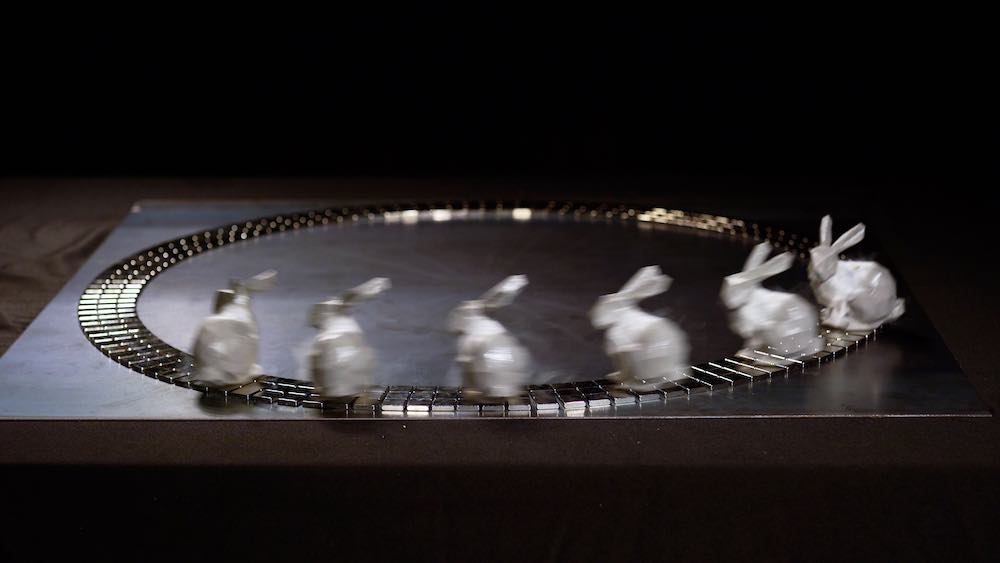
LeviFab は、超伝導浮揚により、物体を宙に浮いた状態で固定・移動させる技術です。物体の最適な内部構造を設計して3Dプリンタで刷り上げるので、形状を問わず浮かせることができます。 地球儀のように対称性のよい物体が浮くのは想像がつくかと思います。しかし、ウサギの模型など⾮対称な物体はうまく調整しないとバランスが崩れて斜めに浮いてしまいます。物体の重⼼が適切な位置になるよう、3Dプリンタで印刷する前にあらかじめ計算して調整しておくことで、バランスが崩れないようにすることができます。磁⽯の反発を利⽤する場合は不安定になりがちですが、超電導浮揚では「ピン⽌め効果」によって横ズレしにくい安定した浮揚になります。磁場⾃体を操 ることで、物体に触れることなく動かすこともできます。 また、物体の内部には超伝導体を -100 ℃以下に冷やすため液体窒素を⼊れる空間も⽤意されています。物体の重⼼だけでなく、熱伝導性も考慮して断熱材を⽤いて内部を加⼯します。そのため物体の中⼼近くは低温ですが表⾯付近は常温に近く保たれ、好奇⼼に溢れた⼦どもたちが触ってしまったとしても⽕傷する⼼配はありません。 また LeviFab を論⽂発表したあとは、超伝導体でなく永久磁⽯を⽤いた磁気浮揚の開発プロジェクトを進めています。これによって、液体窒素を補充する⼿間を省くことができ、⻑期間の展⽰ができるようになります。
< Case >
■Case 1.
PR したい商品の模型をつくって展⽰し、空間全体のデザインにあわせて空中に浮いた状態にしたい。また浮いている模型に 360° すべての⽅向から⾃在にライティングすることもできるようになる。
■Case 2.
カプセル型内視鏡などのように、ヒトの体内に⼊れる診断機器そのものは動⼒を持たないようにしていきたい。⾃然に体内を移動していく形式ではなく、⾝体の外側から⾃由に動かせるような仕組みにできないか。
■Case 3.
宇宙船の無重⼒状態では、物体を机に置いて固定することができない。重⼒のかわりとして磁⼒を活⽤したり、机から離れないまま動き回らせたりすることが可能となる。
< 原理 >
■超伝導体の⼆種の効果による浮揚
磁⼒の分布を最適化するかわりに、浮揚させたい物体に超伝導体を埋め込み、磁場の中に置くというアプローチを⽤いています。 内部に液体窒素を注ぎ込んで冷却することで、超伝導体のマイスナー効果によってオブジェクトを浮揚させます。さらに「ピン⽌め効果」のおかげで安定性の⾼い浮揚が可能となっています。
■三次元モデルの最適化
ただ超伝導体を埋め込むだけでは、オブジェクトはバランスを失ってしまいます。また、内部を -100 ℃以下まで冷却しても表⾯が冷たくならないよう、断熱材で加⼯する必要もあります。 そして、超伝導体と断熱ケースを埋め込む際に重⼼の位置を計算し、内部構造を最適化したオブジェクトを 3D プリンタで刷り上げます。
■主な実績
[Conference] SIGGRAPH 2017, Studio, article no. 5, Los Angeles, California (USA), 7 ⽉ 30 ⽇ - 8 ⽉ 3 ⽇, 2017.
[Exhibition] デジタルコンテンツ EXPO, ⽇本科学未来館, 10 ⽉ 28 ⽇, 2017.
[Media] ギズモード・ジャパン, 9 ⽉ 4 ⽇, 2017.